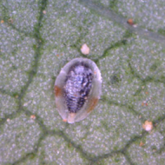Whitefly parasitoids

Encarsia sp. developing inside a whitefly nymph
© Queensland Government

Female Eretmocerous wasp
© T. Grundy, Queensland Government

Eretmocerous larvae developing inside silverleaf whitefly nymphs - the red-eyed nymph (bottom left) is unparasitised
© T. Grundy, Queensland Government
Encarsia and Eretmocerus spp. are tiny (about 0.6mm) wasps with opalescent wings.
- Encarsia was developed as a biocontrol agent for greenhouse whitefly (GW) and works best under warm temperate conditions.
- Eretmocerus hayati was imported and released by the CSIRO in 2004, and has established well in all areas where silverleaf whitefly (SLW) occurs.
Scientific name
Description
Encarsia females are black with a yellow abdomen. Males are rare, larger and black. Parasitised whitefly nymphs turn brown (SLW) or black (GW).
Eretmocerus females are yellow and males are darker with slightly longer antennae. The developing larvae are difficult to see with the naked eye.
Impact on pests
High levels of parasitism leading to significant reductions in pest populations can be achieved in fields that have not been sprayed with broad spectrum insecticides.
Life cycle and ecology
The complete life cycle takes about 4 weeks.
- Eggs are laid individually inside the bodies of whitefly nymphs.
- Wasp larvae develop through 4 instars.
- Adults escape by biting a circular hole in the whitefly nymphal case.
Factors that influence effectiveness
- Encarsia are less effective when relative humidity is over 75% or temperatures are very high.
- Heavy deposits of honeydew or hairy leaves reduce the wasp's ability to hunt.
- Both wasp species are commercially available for inundative release.
- Eretmocerous are very sensitive to a range of pesticides. See the pesticide impact table in the latest Cotton Pest Management Guide.
- Encarsia wasps are very sensitive to pesticide residues, including systemic pesticides applied to the root zone.
Further information
- Encarsia—Goodbugs.org.au
- Eretmocerus—Bugs for bugs
- Identifying parasitism in silverleaf whitefly (video)—CottonInfo